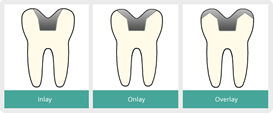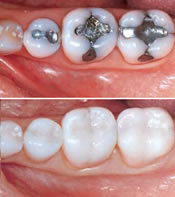What are Inlays & Onlays?
 Dental inlays and onlays are a medium between dental crowns and fillings. They are implicated on teeth at the back of the mouth that has suffered a moderate level of decay. Not only this, but inlays and onlays can also be placed on teeth that have undergone some fracturing; more serious damage will probably be resolved with a dental crown.
Dental inlays and onlays are a medium between dental crowns and fillings. They are implicated on teeth at the back of the mouth that has suffered a moderate level of decay. Not only this, but inlays and onlays can also be placed on teeth that have undergone some fracturing; more serious damage will probably be resolved with a dental crown.
The two main types of inlays and onlays are made from resin or porcelain. It is also not uncommon to see gold versions. However, the inlays and onlays are often more appealing as porcelain and resin as they can be coloured to look natural. This often makes dental inlays and onlays a popular choice for those wishing to replace unattractive fillings that are made from metal.
This type of dental product is bonded into place around the cusps. Onlays are used to cover one cusp or more, whereas dental inlays tend to be used more as a filling between the cusps. This area is vulnerable to damage due to chewing and so is often prone to fracturing.
How long do inlays and onlays last?
Dental inlays and onlays can potentially last for decades, however, it depends entirely on a number of factors. A key influence on how long they exist is the material that the inlay or onlay is composed of. Also, the actual teeth that the product is applied to can be a big determining factor in how long they last for.
Other factors that can affect how much a dental inlay and/or onlay will endure are very dependent on the patient’s actions after the filling-like product has been fixed. These influences are how forceful chewing is as well as choice of food, the level of care that is taken by the patient for the inlays or onlays as well as the oral hygiene routine of the patient. It is also important that the dentist is visited regularly to make sure that the inlays and onlays are intact.
How dental inlays and onlays are applied
 In general, the process of fixing inlays or onlays onto the teeth requires at least two dental appointments. This is because the inlays and onlays must be moulded perfectly to the size and shaped of the individual teeth that require the product.
In general, the process of fixing inlays or onlays onto the teeth requires at least two dental appointments. This is because the inlays and onlays must be moulded perfectly to the size and shaped of the individual teeth that require the product.
At the first appointment, your dentist will extract the damaged part of the tooth. Then the part of the tooth that is remaining will be carefully shaped to ensure that the inlay or onlay will be able to stick. This shaped tooth provides the model for an impression to be made. A gum will be put inside your mouth so the dentist can make a mould of the tooth shape as well as your bite. This mould is an exact replica of your mouth so the inlays and onlays can be perfectly constructed in the laboratory.
Your following appointment will involve the actual application of the inlay or only onto the necessary teeth. The inlay or onlay is carefully positioned so it matches the exact shape of the tooth. Once in position, your dentist will then work on permanently binding the inlay or onlay onto the tooth. This inlay/onlay is then polished to ensure you leave the clinic with a bright, shiny smile.
Does the procedure hurt?
As the procedure of obtaining a dental inlay or onlay requires the removal of tooth as well as dental shaping, there is bound to be some degree of pain. However, your dentist is able to minimise this by injecting a local anaesthetic. This injection acts of the nerves in a localised area and numbs it.
It is relatively rare that any residual pain occurs after either the first, preparatory procedure or the subsequent fixing procedure. If there is pain, it tends to be rather dull and throbbing but can be relieved with over-the-counter painkillers such as ibuprofen or aspirin.
Dental inlay and onlay benefits
 There are a number of positive points that are associated with dental inlays and onlays. Primarily they are very useful in the treatment of tooth decay as well as getting rid of sensitivity of the teeth and tooth loss. Other benefits of dental inlays and onlays include:
There are a number of positive points that are associated with dental inlays and onlays. Primarily they are very useful in the treatment of tooth decay as well as getting rid of sensitivity of the teeth and tooth loss. Other benefits of dental inlays and onlays include:
- The ability to choose natural coloured inlays or onlays to make them "invisible" so your smile will not be made more unattractive.
- As the inlays and onlays are generally not composed of metal, like conventional fillings, they will not change in shape or size if the teeth are subjected to changes in temperature.
- More of your tooth is maintained than with a traditional filling, which often makes the procedure more appealing and popular.
- Dental inlays and onlays can strengthen the tooth in question by around 75% thanks to the process that goes into producing them.




